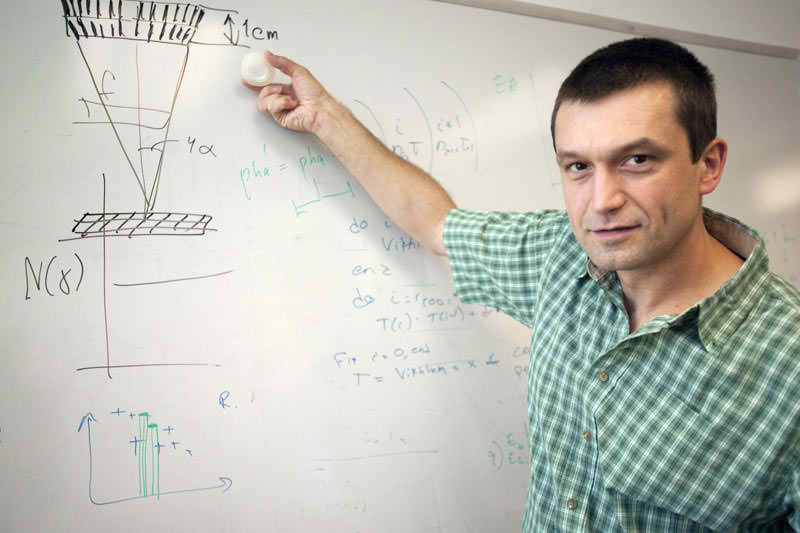NASA X-Ray Mirror Idea Inspired by Scotch Tape (No, Really!)

Scotch tape, that transparent, sticky hero of offices everywhere, could be a NASA superstar as well.
The rolled-up adhesive tape is the inspiration behind a novel idea for a completely new kind of X-ray mirror for big telescopes in space. The concept, dreamed up by NASA scientist Maxim Markevitch, is this: Instead of building an expensive telescope mirror to capture high-energy "hard" X-rays in space, why not create a mirror from tightly rolled plastic tape at a much lower cost?
"I remember looking at a roll of Scotch tape and thinking, 'Was it possible to use the same design for capturing hard X-rays?'" Markevitch explained in a NASA statement. "I talked with a few people, and to my surprise, they didn't see any principal reasons why it couldn't be done."
Markevitch and a team of other X-ray space optics experts at NASA's Goddard Space Flight Center in Greenbelt, Md., have begun testing materials that could be used to build a rolled mirror sensitive enough to collect hard X-rays from deep space. [Giant Space Telescopes of the Future (Infographic)]
Capturing 'hard' X-rays
Several space telescopes already scan the heavens for X-rays today, including NASA's Chandra X-ray Observatory and black hole-hunting NuSTAR instrument, as well as Japan's New X-ray Telescope (which is also known as Astro-H).
But Chandra is sensitive to lower-energy "soft" X-rays, and NuSTAR and Astro-H have limited collecting areas that allow them to only "graze the surface" of possible discoveries in the hard X-ray realm, Markevitch said.
Get the Space.com Newsletter
Breaking space news, the latest updates on rocket launches, skywatching events and more!
To really do the job, scientists need an imaging X-ray telescope with a collecting area perhaps 30 times larger than that of NuSTAR, he added. If such a telescope could be built, it could study galactic cosmic rays, super-fast subatomic particles generated in deep space.
Scientists believe cosmic rays and the magnetic fields between galaxy clusters can alter the physics within clusters. A better understanding of these physics could reveal more about the birth and evolution of the universe, Markevitch said.
But a telescope capable of making such finds using current technology — which would require building a large number of individual mirror segments, coating them with reflective material and them nesting them precisely inside an optical assembly — doesn't appear to be coming along anytime soon.
"However, to our knowledge, nothing of the kind is planned or even proposed in the U.S. or elsewhere because of the cost something like this presents," Markevitch said.
Just a concept — for now
Markevitch and his team hope a new way of thinking could help push such a project along.
Their idea calls for coating plastic tape on one side with multiple layers of reflective material, then winding the tape into a roll to form a large number of densely packed nested shells. This process could theoretically create a mirror with a huge collecting area, Markevitch said.
While the team is currently testing candidate materials, the idea is still a long way from getting off the ground.
"Maxim's Scotch tape idea is in an early stage," said team member Will Zhang, also of NASA Goddard. "In the next year, we will know whether it has a chance of working."
If the tape does indeed work, it could be "game-changing for hard X-ray astronomy," Markevitch said. "It could significantly reduce the cost of building large mirrors, bringing within reach the possibility of building a mirror with 10 to 30 times greater effective area than current X-ray telescopes."
Follow SPACE.com for the latest in space science and exploration news on Twitter @Spacedotcom and on Facebook.
Join our Space Forums to keep talking space on the latest missions, night sky and more! And if you have a news tip, correction or comment, let us know at: community@space.com.

Space.com is the premier source of space exploration, innovation and astronomy news, chronicling (and celebrating) humanity's ongoing expansion across the final frontier. Originally founded in 1999, Space.com is, and always has been, the passion of writers and editors who are space fans and also trained journalists. Our current news team consists of Editor-in-Chief Tariq Malik; Editor Hanneke Weitering, Senior Space Writer Mike Wall; Senior Writer Meghan Bartels; Senior Writer Chelsea Gohd, Senior Writer Tereza Pultarova and Staff Writer Alexander Cox, focusing on e-commerce. Senior Producer Steve Spaleta oversees our space videos, with Diana Whitcroft as our Social Media Editor.









